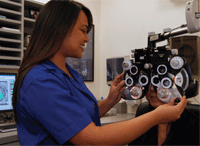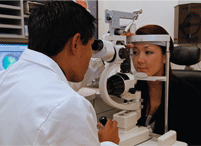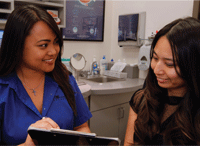Contact lens wearers represent an average of 37% of the typical practice’s patient base and contribute 29% of net revenue of the average practice.1 These days, more of the contact lens services can be delegated to ancillary personnel, along with the incorporation of instrument technology to gather data, design lenses and provide useful metrics during follow-up case management.

Practitioners can delegate
information gathering, initial parameter selection, lens application,
initial fluorescein evaluation and over-refraction to a technician.
Photo: Orlando Guiang, O.D. (www.eyemanpix.com)
This may be disruptive for practitioners who conduct the majority of their baseline data gathering, diagnostic evaluations and follow-up case management. But, this is not new to some who already practice this way.
Time and Services
I began practice as a new licentiate in 1968. That year, the standard fee for contact lenses, after the examination fee, was $225 and there were few practitioners who charged more and few who charged less. The cost of a pair of PMMA lenses (the only lenses available) averaged $16. Convert the lens cost in 1968 dollars to 2009 dollars, and you get about $99 today.2 Convert the fitting fee of $225 to 2009 dollars, and you get $1,390 today.2
I can hear the sighs from here. Contact lenses enjoyed a healthy gross margin and profit. At the same time, the chair time in fitting PMMA lenses was substantial. So, the comparison is incomplete without an analysis of chair time. Also, the most skilled optometrists at that time conducted in-office lens modification, and their time included standing over a modification unit and adjusting secondary and peripheral curves along with diameter, edges and lens power. Even so, the average total time in fitting over a six-month service period very likely averaged about three hours.
Today, the treatment of choice is the disposable lens, with an average fee for evaluation, case management and an annual supply of lenses being about $300, with the cost of goods being about $160. The average time in fitting over the service period included is, let’s say, 45 to 60 minutes.
If we convert the 1968 scenario into gross profit per hour, it’s $1,390 ÷ 3 = $463 per hour. Compare that to the 2008 scenario of $140 ÷ 1 = $140 per hour. You’d have to double the 1968 time and halve the 2008 time to reach relative equality.
Some of you will say that the $300 fee for services and materials today is also under price pressure and difficult to obtain.
You may also say that you fulfill an ever-decreasing percentage of your prescriptions. In 1968, a practitioner filled all of them, because the lens and the practitioner were inseparable.
This begs the question: Does it make sense for you to be the primary labor provider for your contact lens services?
When you
delegate most of the data gathering of the contact lens visit, your
chair time can be reduced to final fluorescein evaluation,
decision-making and prescribing. Photo: Orlando Guiang, O.D.
(www.eyemanpix.com)
Elasticity of Demand

Delegating CL data gathering is efficient not only with conventional soft lenses and GPs, but it’s even possible with specialty lens prescribing. One is corneal refractive therapy (CRT). Another may be the use of specialty hybrid or scleral lenses for patients with regular eyes who simply want better vision. These services, under the traditional paradigm, take extra time and are found to be disruptive to the crunch scheduling that is common in today’s practice.
As a result, it is common practice for the practitioner to surcharge the materials and add a healthy margin for the services. For example, practitioners charge $1,500 to $2,500 for a three-month CRT treatment plan. It is also common for practitioners to charge $400 to $500 for a pair of hybrid contact lenses and $300 for the evaluation and case management. Some practitioners charge as much as $2,000 to $3,000 for scleral lens evaluation, case management and lenses. Custom soft torics, corneal GP, and even disposable multifocals command premium fees in most practices.
These are reasonable fees when compared to those in 1968. The problem is with the elasticity of demand. In 2000, a beta market research study found that 20 million Americans were interested in CRT. When asked about their readiness to make a decision based on the price of the procedure at a fee of $1,500, the number was cut to half when compared to those who expressed readiness if the fee was under $1,000.3 While we can find shortcomings of such studies, the research shows that the demand is elastic as a function of the fee.
Today, the average CRT practitioner spends 1.5 hours in patient time over a three-month period.4 Modalities with lower first-fit success rates and those requiring lens exchanges to achieve a successful final fit (e.g., multifocals, scleral lenses and corneal GP lenses) also require significant chair time for initial lens selection and subsequent case management. Practitioners also find that there are scheduling challenges when specialty contact lens care is mixed with regular refractive and medical eye care. The astute practitioner should always ask: What daily activities can I delegate to ancillary personnel who, if properly trained and equipped, can perform the task equally (or better) at a lower cost?
There is no question—if I were in practice today, I would delegate a large portion of the information gathering, task completion and case management of contact lens care. I would not delegate the diagnosis, decision-making, consultation or prescribing. Those are the core constituents of the fiduciary responsibility of my licensure. Again, the question is: What activities can I delegate to ancillary personnel who, if properly trained and equipped, can perform the task equally (or better) at a lower cost?
What activities can you delegate to ancillary personnel who can perform the same tasks at a lower cost? Photo: Orlando Guiang, O.D. (www.eyemanpix.com)
High-Tech Prescribing

We have arrived at the time when the majority of contact lens brand and design selection can be achieved by predictive markers or metrology. Most of the decision trees in our minds can be reduced to algorithms that suggest starting lenses for a patient’s eyes. This is certainly true for corneal refractive therapy and is being supported by new software. Several companies have pioneered the field of topography-driven software for GP and soft lenses. Software and systems are in development for suggesting initial lens parameters for scleral lenses.
The time has come that practitioners can delegate information gathering, initial parameter selection, lens application, initial fluorescein evaluation and over-refraction or over-aberrometry. Chair time can be reduced to final fluorescein evaluation, decision-making and prescribing.
Case history, visual acuity, over-refraction, fluorescein evaluation and other information gathering on case management visits can be delegated. Again, chair time can be reduced to your review, decision-making and prescribing.
The 45 to 60 minutes of practitioner time in soft lens fitting and follow-up, the 1.5 hours for CRT, and the time in scleral lens fitting can be reduced to one-half or one-third by delegating.
Technology for Value
After the process of training and equipping ancillary personnel, the question becomes: Will I enjoy the improved productivity and profitability, or will I reduce my fees in an effort to appreciate increased demand?
That is certainly a “comfort zone” issue for each practice owner. We know from many successful industries that driving the cost out of the supply chain is a key to industry success.
High prices (fees) are a poor way to get consumers to appreciate value. Value is part of the new economy, and comes with improved quality of life for the consumer. For example, the consumer electronics industry produces awesome products and services at a cost that is affordable to the vast majority of consumers.
Can all the channel participants in the contact lens industry achieve something like this? Is there a point when we feel foolish to hold up a pair of hybrid lenses and say they cost $499 (no services included), when a 42” high-definition flat screen TV costs less? Something seems wrong with this picture.
The contact lens industry offers so much by adding to the quality of life of consumers who want to enjoy a rich visual world. Independent practitioners have been the mainstay of the profession and offer trustworthy, compassionate, stable delivery of care.
Technology and systems of delivery are the keys to enjoying practice more, increasing productivity and making our services and materials more affordable to our patient base. The comparative economics and elasticity of demand suggest a change in the paradigm and emerging technology and a willingness to train and equip ancillary personnel can make it possible.
Dr. Legerton was in private practice in San Diego for 26 years, followed by 16 years in product development with Pilkington Barnes Hind, VISX, Paragon Vision Sciences and SynergEyes. He holds 23 patents for aberration-blocking contact lenses, presbyopic laser refractive surgery, corneal refractive therapy, hybrid contact lenses and myopia progression control. He is the recipient of the 2010 Achievement Award from the Cornea and Contact Lens Section of the American Optometric Association.
1. Nichols JJ. Contact lenses 2009. Contact Lens Spectrum. 2010 Jan;25(1):20-7.
2. Officer LH, Williamson SH. Purchasing Power of Money in the United States from 1774 to 2009. MeasuringWorth. 2010. Available at:
www.measuringworth.com/ppowerus (accessed June 11, 2010).
3. Beta Research Corporation. Corneal refractive therapy: a survey among consumers. May 2001.
4. Paragon Vision Sciences. Internal quality survey.

